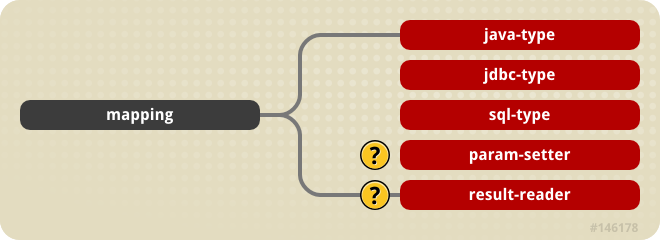31.13.3. Mapping
A
type-mapping is simply a set of mappings between Java class types and database types. A set of type mappings is defined by a set of mapping elements, the content model for which is shown in Figure 31.19, “The jbosscmp-jdbc mapping element content model.”.

Figure 31.19. The jbosscmp-jdbc mapping element content model.
If JBoss cannot find a mapping for a type, it will serialize the object and use the
java.lang.Object mapping. The following describes the three child elements of the mapping element:
- java-type: This required element gives the fully qualified name of the Java class to be mapped. If the class is a primitive wrapper class such as
java.lang.Short, the mapping also applies to the primitive type. - jdbc-type: This required element gives the JDBC type that is used when setting parameters in a JDBC
PreparedStatementor loading data from a JDBCResultSet. The valid types are defined injava.sql.Types. - sql-type: This required element gives the SQL type that is used in create table statements. Valid types are only limited by your database vendor.
- param-setter: This optional element specifies the fully qualified name of the
JDBCParameterSetterimplementation for this mapping. - result-reader: This option element specifies the fully qualified name of the
JDBCResultSetReaderimplementation for this mapping.
An example mapping element for a short in Oracle9i is shown below.
<jbosscmp-jdbc>
<type-mappings>
<type-mapping>
<name>Oracle9i</name>
<!--...-->
<mapping>
<java-type>java.lang.Short</java-type>
<jdbc-type>NUMERIC</jdbc-type>
<sql-type>NUMBER(5)</sql-type>
</mapping>
</type-mapping>
</type-mappings>
</jbosscmp-jdbc>

